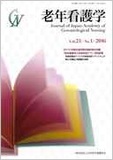Japanese
English
- 販売していません
- Abstract 文献概要
- 参考文献 Reference
抄録
本研究の目的は地域包括支援センターが把握した地域でひとり暮らしをしていた高齢者の孤立死の類型化を行い,地域包括支援センターの孤立死に対する活動について示唆を得ることである.2014年4月から6月にA県の全地域包括支援センター249か所の看護職各1人を対象に質問紙調査を行い,81部(回収率32.5%)を回収した.そのうち依頼に応じてくれた10人にインタビュー調査を行った.質問紙調査では,孤立死の相談が「ある」は51センター(63.0%)であった.相談者は,「民生委員」が最も多く31件(60.8%),「近所の人」20件(39.2%),「民間宅配業者」13件(25.5%)などであった.質問紙調査とインタビュー調査で得られた孤立死の事例は27事例で,【1週間以上前の旅立ち】【見守りによる旅立ち】【看取りによる旅立ち】に分類された.地域包括支援センターが行う活動として,高齢者への緩やかな見守りと孤立死発見時の初動対応の周知や,関わった人に対しては高齢者を見守る役割の明確化と事後のグリーフケアやエンパワメントの必要性が示唆された.
The objective of the present study was to obtain suggestions for the activities of Community Comprehensive Support Centers (hereafter, Centers) concerning isolated death by classifying the cases of isolated death among elderly people living alone in the community documented by Centers. A questionnaire survey was conducted on one nursing staff each at all 249 Centers in Prefecture A between April and June 2014, and a total of 81 responses (response rate, 32.5%) were obtained. An interview survey was then conducted on 10 respondents who complied with the request. On the questionnaire survey, 51 Centers (63.0%) responded that they had received consultations regarding isolated death. These consultations were most often made by “social workers” (n=31; 60.8%), and were also made by “neighbors” (n=20; 39.2%) and “deliverymen for private delivery companies” (n=13; 25.5%), among others. A total of 27 cases of isolated death were obtained from the questionnaire and interview surveys, and they were classified as “death occurring at least a week earlier”, “death occurring after mimamori*”, and “death occurring after end-of-life care”. These findings indicate that the activities performed by Centers must include gradual mimamori toward elderly people, promotion of awareness regarding initial responses at the time of encountering a case of isolated death, and the clarification of roles in mimamori toward elderly people as well as grief care and empowerment following death for the people involved.
*mimamori : Maintaining distance by considering the feelings or circumstances of elderly people, confirming the safety of elderly people by observation and/or measurement, and understanding the needs of elderly people by cooperating with people and institutions in the community
Copyright © 2016, Japan Academy of Gerontological Nursing All rights reserved.


